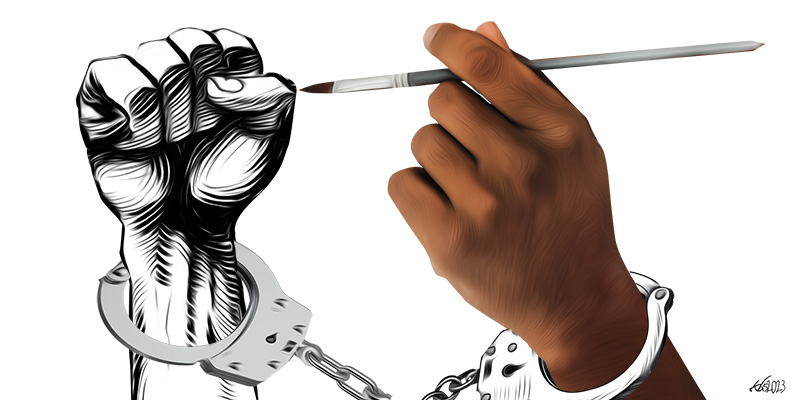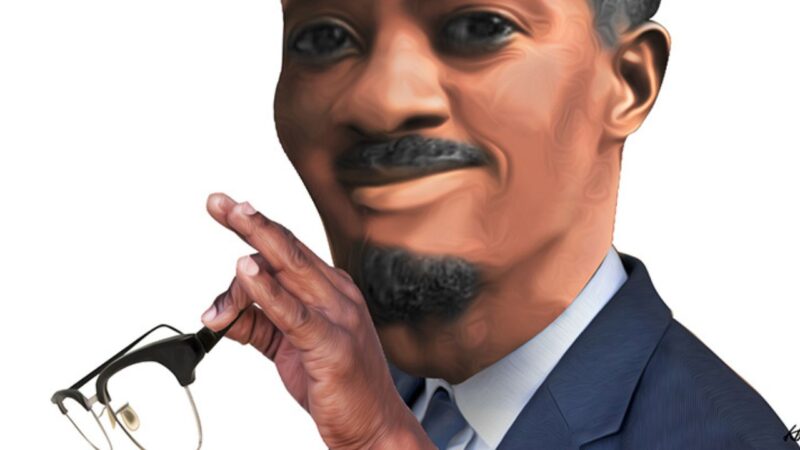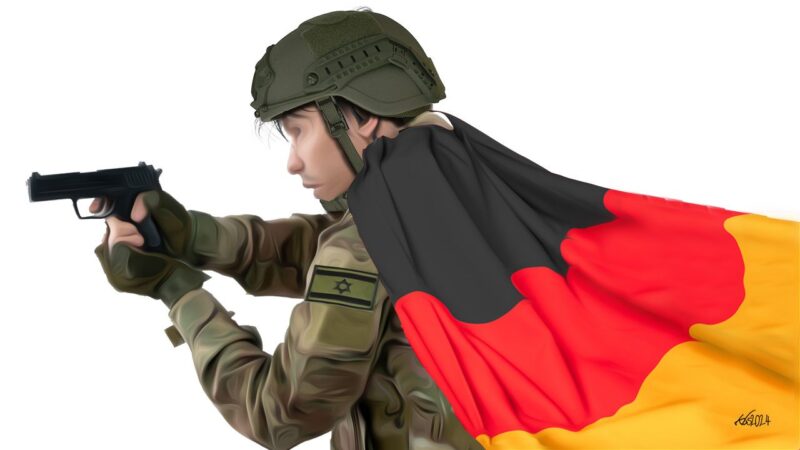In Kenya, editorial cartoons have without a doubt been the solid foundation upon which comics have grown and been widely appreciated. Editorial cartoons are a main feature for many newspapers and magazines and, in fact, many readers first go to the day’s editorial cartoon before reading the rest of the paper.
Editorial cartoons, also often referred to as political cartoons, are defined “as illustrations or comic strips containing a political or social message that usually relates to current events or personalities. Political cartoons can be very funny, especially if you understand the issue that they’re commenting on. Their main purpose, though, is not to amuse you but to persuade you. A good political cartoon makes you think about current events, but it also tries to sway your opinion toward the cartoonist’s point of view.”
This definition holds for Kenya where editorial cartoons have provided effective political commentary from the Terry Hirst days in the 1970s right down to the present-day with cartoonists Gado (previously in the Daily Nation and The East African and currently in The Standard), Victor “Vic” Ndula (The Star), Stanslaus “Stano” Olonde (The People Daily and previously Taifa Leo), Samuel “Igah” Muigai (Taifa Leo) and Munene Michael (Daily Nation). Gado’s editorial cartoons are syndicated and he is also a regular contributor to other international newspapers including Deutsch Welle (Germany), New African (UK), Courrier International (France), Business Day and Sunday Tribune (SA).
Others who have over time—the 1980s, 90s…—left their mark as astute editorial cartoonists are Paul “Maddo” Kelemba (Daily Nation and The Standard), the late Frank Odoi (Daily Nation, The Standard and numerous international publications), James “Kham” Kamawira (Kenya Times, Nairobi Weekly Chronicles, The Standard), the late Joshua Nanjero (Kenya Times, Weekend Mail, Sudan Mirror, Sunday Express), Celeste (The People Daily), Eric “Gammz” Ngammau (The Nairobian, The Standard), Bill Okutoyi (The Standard), Patrick Gathara (Daily Nation, The Star), David “Tum” Kiptum (Kenya Times) and David “Mwalimu” Karogo (The People Daily).
As editorial cartoonists, all these artists have contributed significantly to raising political awareness in the country and to the political reforms that have taken place. They have created illustrations or comic strips that carry political or social messages about defining moments in the country’s history that have resonated with Kenyans, illuminating the country’s social-economic-political issues with humour and in a way that is easily understood.
The late Terry Hirst made his mark in the 1970s with his column Hirst on Friday and later through his lead character Joe in Joe magazine. “The marketing department of the Nation group invited me to be the first editorial cartoonist on the Daily Nation and Hirst on Friday became beneficial to the paper, as subsequent surveys showed,” Terry Hirst told Kymsnet. “But in those days, the newspapers were still working out their relationships with politicians and commerce and it was difficult to always be sure of ‘the party line’ from editorial. At first, they even tried to change my captions, without reference to me, until I protested vehemently about independence. In the end we compromised, with me leaving mild ‘joke’ drawings in advance, in case they felt unable, or unwilling, to use the current drawing.”
Political cartoons have, “according to the 2007 documentary The Political Dr. Seuss, ‘taken their place on the page and screen as valid outlets for expressing political thought, championing activism and affecting social change through creative use of visual art.’” Today, political cartoons can be found in newspapers, magazines, in the opinion and cartoon pages—practically everywhere you look.
This is particularly true in Kenya in relation to the political upheavals that followed in the wake of the failed military coup d’état of August 1982. Even before this, however, there was discontent with the political establishment, hence the uneasy relationship between the press and politicians alluded to by Terry Hirst. This disquiet started almost immediately after independence when retrogressive amendments were introduced into the independence constitution. These changes were made amidst unexplained political assassinations, corruption, nepotism, favouritism, marginalisation of communities and even individuals. The amendments significantly changed the political landscape and discourse.
However, things took a turn for the worse following the attempted coup, with civil and political liberties tested to the limit in the 80s and 90s and even after we ushered in new millennium. During this time, the country became a single-party dictatorship and this did not only ensure a shrinking of the political space but civil liberties and freedoms such as freedom of association, freedom of information, freedom of expression, etc., were also grossly curtailed.
This disquiet started almost immediately after independence when retrogressive amendments were introduced into the independence constitution.
When citizens started to agitate for greater freedom and reforms, the media added its voice to this drive, with editorial cartoons carrying political or social messages that aptly captured the political mood.
Speaking to Kymsnet, Paul “Maddo” Kelemba, then working for the Nation Media Group, said, “As a young cartoonist with fire burning inside me, I really wanted to splatter out all over the place what was in my mind but of course, not much would have gotten past the editors of the time. Besides, one had to be extremely careful too. I tried to be cunning and hide some messages in my work in an effort to beat the editor first and then the state agents second.”
Maddo told how writers, journalists, cartoonists, etc., would be given copies of the “seditious” Mwakenya publication by the notorious Special Branch agents who would then gauge one’s reaction. If you kept quiet, they knew you were “sympathetic” to the “dissidents” and they would zero in on you. Many journalists like the late Wahome Mutahi—also known as Whispers and a close friend of Maddo—were arrested right under their colleagues’ noses at the Old Nation House.
This didn’t deter them. As the agitation grew and citizens became more emboldened, cartoonists also took the cue. In the early 1990s, Maddo did the unexpected when he caricatured the then president in an editorial cartoon that also appeared on the cover page of Society magazine, a pro-reform publication that was critical of the regime. This was unprecedented. Journalists, academics, politicians, student leaders, trade unionists and activists had been arrested and detained without trial for far lesser “crimes” and everyone expected the worst to happen.
“My cartoon of then President Moi was the first to be openly published and it was a gamble worth taking. But let’s set the record straight,” Maddo told Kymsnet, “I was not the first to cast President Moi as a cartoon character. University of Nairobi students beat me to it in the early ’80s, albeit their graffiti did not go beyond the pedestrian tunnel near the campus.”
Maddo added: “The editor, Pius Nyamora—at Society which published the cartoon—and I were in agreement that we should test the waters. It was an elaborate, full colour and bang on the cover, accusing President Moi of being unfair to his 1992 polls opponents by putting hurdles in their way. His opponents then included the late Jaramogi Oginga Odinga, Kenneth Matiba, Mwai Kibaki who would later become the third president of Kenya, and others.”
Journalists, academics, politicians, student leaders, trade unionists and activists had been arrested and detained without trial for far lesser “crimes”.
“The magazine used to hit the streets on Mondays and this edition arrived to the sheer excitement of some and utter shock of others,” said Maddo, recalling the events of the day the cartoon was published. “Some people were apprehensive about purchasing a copy for one could be arrested for carrying a “seditious publication”. That day, Nyamora, who had been petrol-bombed before, didn’t turn up in the office. I waited patiently at the Standard’s offices on Likoni Road. Nothing. There wasn’t a ranting Moi or a chorus of condemnation from his lieutenants and no state security agents seeking out the editor, his cartoonist and printer. Neither did the agents go around buying all the copies like they had done before with publications they considered to have acrid content.”
“As I painted that cartoon, I had no doubts that we were on the threshold of Moi’s final years of absolute political control. I was so convinced that he’d lose at the first multi-party polls,” Maddo reminisced. “If I was locked up, it wouldn’t be long before I was free again. But I also considered the other side. I had tried to convince my then editor at the Standard, Ali Hafidh, that we could start caricaturing the hitherto untouchable elements of the Kanu regime but he would hear none of it. I did, however, slowly introduce Moi into my editorial cartoons under disguise. I had always figured out one thing: maybe Moi was not all that overly hostile to cartoons. The stumbling blocks were the editors and Moi’s cronies who probably blacked out critical stories in a newspaper before giving it to him. Having survived that Monday, the media, Kenyans and Kanu knew that Moi could be depicted in a cartoon. Daily Nation’s Gado, freshly on the job, took cue and went on to produce some of the most stinging cartoons on the then president.”
Maddo’s was the editorial cartoon that redefined the state-media relations and broke the myths that had been developed by state agencies about the presidency and freedom of expression. In subsequent years, editorial cartoonists continued to raise the bar, endearing themselves to Kenyans in the process as they raised pertinent issues affecting the society.
According to the Ohio State University’s History Teaching Institute, “a good cartoon is one that combines a clear drawing and good writing, expresses a recognizable point of view or opinion and cannot be read or understood by only looking at the words or only looking at the picture. Both the words and the pictures must be read together in order to understand the cartoonist’s message. They further note that not all editorial cartoons are meant to be funny. Some of the most effective editorial cartoons are not humorous at all. Humour is only one tool available to editorial cartoonists.”
Cartoonists also use various other devices to get their message across. Some of these devices include the use of “symbols (simple pictures that are understood to stand in for ideas or groups); caricatures (drawing of a person that exaggerates his characteristics for comic effect); stereotypes (generalization, usually exaggerated or oversimplified and often offensive, that is used to describe or distinguish a group); analogies (comparisons—this thing is like the other thing); juxtaposition (positioning people or things side by side); irony (use of words to convey a meaning that is the opposite of its literal meaning, an outcome of events contrary to what was expected); captioning and labels (used for clarity and emphasis).”
Kenyan editorial cartoonists have used all these devices and styles to bring societal issues to the fore and, more importantly, to bring more people to appreciate the power of comics as a tool of communication and education. They have employed these devices to eloquently and boldly speak on the peoples’ behalf. Most editorial cartoons are derived from news and events from around the country and in this way they resonate with the people. However, in a country saturated with politics, political issues tend to dominate the content of editorial cartoons.
Not all editorial cartoons are meant to be funny. Some of the most effective editorial cartoons are not humorous at all.
Quoting Prof Levi Obonyo’s PhD dissertation on Kenyan cartooning, Drawing the Line—a publication of the East African Cartoonists’ Society (KATUNI)—writes: “Cartoons have served as commentaries on political issues, a synthesised rendition of the … news, and a depiction of the socio-economic condition of the society. The public perceives cartoonists as fearless and objective, if humorous, commentators on the behaviour of hitherto untouchable politicians. Their use of pennames, such as Gado and Maddo, may insulate them from accusations of ethnic bias.”
Great strides have been made but editorial cartoonists still face some daunting challenges particularly from the political elite who continue to be the subject of their stinging political commentary. The Constitution of Kenya (2010) has an elaborate and comprehensive Bill of Rights that protects cartoonists but freedom of expression remains a challenge for cartoonists, some of whom, in extreme cases, have ended up losing their jobs. Maddo sums it up in this quote:
“Politicians have continued to notice my work more and more. Some respect it, others pour scorn on it. I cherish both opinions. Incredulously, while we cartoonists struggled to bash politicians in the Kanu era, we’ve found criticizing today’s political leaders tricky because they always rush to court. It’s a bit like they are the ones who are supposed to be the sole beneficiaries of today’s freedoms. They have discovered that they can sue. Kenya’s media along with civil society was at the forefront of fighting for reforms. The ruling class, which is largely a disguised Kanu, wants to deny this. Unfortunately, too, there is no difference between politicians from both the ruling and opposition side the divide.”








